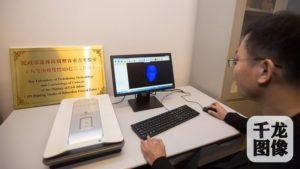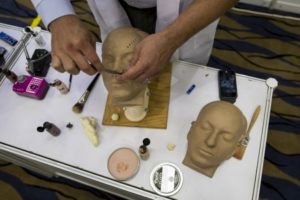3D Printing for Mourners: Chinese Funeral Home Turns to 3D Technologies to Reconstruct Faces of the Deceased for Open Casket Funerals
 Some people find the mourning process for the death of a loved one to be even more difficult if the deceased does not have an open casket funeral. This can happen if the deceased person suffered any disfiguring or deforming injuries, like in the case of a fire or car crash. While undertakers and mortuary cosmetologists are able to complete facial reconstructions with plaster and plastic cement, the process can take up to a week, delaying the funeral or farewell ceremony. But a Chinese funeral home has found a way to give grieving families open casket funerals for their loved ones – by using 3D printing technology to reconstruct the faces of the deceased much quicker.
Some people find the mourning process for the death of a loved one to be even more difficult if the deceased does not have an open casket funeral. This can happen if the deceased person suffered any disfiguring or deforming injuries, like in the case of a fire or car crash. While undertakers and mortuary cosmetologists are able to complete facial reconstructions with plaster and plastic cement, the process can take up to a week, delaying the funeral or farewell ceremony. But a Chinese funeral home has found a way to give grieving families open casket funerals for their loved ones – by using 3D printing technology to reconstruct the faces of the deceased much quicker.
It used to take three to seven days to reconstruct a person’s face using traditional materials and methods, like gypsum plaster, embalming fluid, plastic cement, and hand stitching. But the funeral home’s 3D printer can build a complete facial mold in half a day, while a partial reconstruction takes just three to four hours. The 3D printed mold can be created quickly and conveniently, and is easy for any of the funeral home workers to make.
Deputy director Li Yuguang, 101 Research Institute, said, “After scanning a 2D photo of the deceased into the computer program, a worker can generate a full 3D digital model of the deceased person’s face with just the touch of a mouse button.”
- [Image: Qianlong network reporter Chen Jian]
- [Image: Reuters]
While the Babaoshan Funeral Parlor is the first in Beijing to use 3D printing technology, it’s certainly been used in the Chinese mortuary industry elsewhere. The IB Times reports that last year, the Longhua Funeral Home was the first in the country to repair corpses by creating accurate replicas of missing body parts through 3D printing technology. We’ve also seen a Chinese funeral platform turn to 3D printed urns for cremation, a trend that has also taken hold in Japan and in the US (and even for Prince). But no matter how much innovative technology is introduced, in China, the death care industry, while offering plenty of job opportunities and a good salary, is still traditionally looked upon with some suspicion.
Taiwanese instructor Lin Leijie said, “Traditionally, older folks would say this profession is only for those people who are not married, have no children, and have no choice.”
Death care workers, like undertakers, are essentially social outcasts, and can be thought of as unlucky. In an attempt to change this opinion, the Ministry of Civil Affairs even hosted the National Cremation Skills Competition; the winner received China’s most prestigious workers’ award, the May 1 Labor Medal. But the people who take care of the deceased still don’t garner much respect, and China’s funeral industry is making attempts to overcome this.
 In addition to its 3D printing studio, the Babaoshan Funeral Parlor also introduced its new smart robot cleaner, which could reduce the need for human workers in the funeral parlor. The white robot, which stands a meter tall, will detect the size of the room, and send out a disinfecting aerosol spray of hydrogen peroxide. Just like with its 3D printing studio, the funeral parlor worked with the 101 research Institute to introduce the cleaning robot. Qu Jie, who works in the funeral parlor, said that the robot can get rid of viruses and germs, as well as the “potential risk to the families of the bereaved, to us funeral parlor workers, and also to our own families.”
In addition to its 3D printing studio, the Babaoshan Funeral Parlor also introduced its new smart robot cleaner, which could reduce the need for human workers in the funeral parlor. The white robot, which stands a meter tall, will detect the size of the room, and send out a disinfecting aerosol spray of hydrogen peroxide. Just like with its 3D printing studio, the funeral parlor worked with the 101 research Institute to introduce the cleaning robot. Qu Jie, who works in the funeral parlor, said that the robot can get rid of viruses and germs, as well as the “potential risk to the families of the bereaved, to us funeral parlor workers, and also to our own families.”
Qu continued, “Now, it is more safe for our families.”
 Robots like this one, and 3D printing technology, are said to help reduce disease in funeral parlors, but according to the Pan-American Health Organization (PAHO), part of the World Health Organization, this is a common misconception, and that dead bodies don’t make people sick from bacteria as often as thought. PAHO explained that, even though many people think that decomposing bodies from major disasters can cause disease to spread, it’s actually just a myth.
Robots like this one, and 3D printing technology, are said to help reduce disease in funeral parlors, but according to the Pan-American Health Organization (PAHO), part of the World Health Organization, this is a common misconception, and that dead bodies don’t make people sick from bacteria as often as thought. PAHO explained that, even though many people think that decomposing bodies from major disasters can cause disease to spread, it’s actually just a myth.
Regardless of whether or not the 3D printing technology now utilized in the Babaoshan Funeral Parlor keeps disease from spreading, we do know that it can help family members say goodbye to their loved ones with a dignified and meaningful open casket funeral. Discuss in the Chinese Funeral Homes forum at 3DPB.com.
[Sources/Images: IB Times, Hexun News, The Beijinger]
Subscribe to Our Email Newsletter
Stay up-to-date on all the latest news from the 3D printing industry and receive information and offers from third party vendors.
You May Also Like
Air Force Awards Fortius Metals $1.25M to Qualify 3D Printing Wire for Hypersonic Applications
AFWERX, part of the US Air Force Research Laboratory (AFRL), awarded a Direct-to-Phase II Small Business Innovation Research (SBIR) contract worth $1.25 million to Colorado’s Fortius Metals, to accelerate qualification...
US Air Force Awards JuggerBot $4M for Large-format Hybrid 3D Printing
Large-format 3D printer manufacturer JuggerBot has received a $4 million grant to develop a large format 3D printer, courtesy of the Under Secretary of Defense, Research and Engineering Manufacturing Technology...
Where Have All AM’s Unicorns Gone?
In the rapidly evolving world of 3D printing, startups valued at over a billion dollars, known as unicorns, once seemed as fantastical as the mythical creatures themselves. While a few...
How My Childhood Fascination with Planes Led to Investing in 3D Printing
My fascination with aerospace started young, and I started studying planes–identifying them in the sky and learning everything I could about how they work. Fast forward to my first week...


































